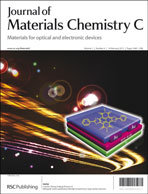Several electrically neutral, highly quadrupolar derivatives of the [closo-B10H10]2− cluster (I) substituted in the apical positions with onium fragments derived from 4-alkoxypyridine, 4-pentylthian, 4-pentylquinuclidine, or dinitrogen were synthesized from the parent cluster in 2–5 steps, and their thermal, structural, photophysical and dielectric properties were investigated. Only derivatives 2, containing thianium and alkoxypyridinium substituents with linear alkyl chains, exhibit liquid crystalline behavior and form a nematic phase. α-Branching of the alkoxy chain leads to marked destabilization of both crystalline and nematic phases, which suggests the importance of polar interactions in phase stabilization of these compounds. Derivatives 2 and 3 with one π and one σ substituent, Q+, exhibit a directional cluster-to-Q charge transfer and increase of the net electric dipole moment to μe = 17.9 D for 2a upon photo-excitation. They are weak fluorophores (Φf = 2–7%). Detailed investigation of 4-heptyloxypyridinium derivative 2b revealed that it exhibits a nematic phase above 100 °C with Δε = +1.3 (130 °C), and a moderate negative solvatochromism. Hyper-Rayleigh scattering measurement gave βHRS = 45 ± 10 × 10−30 esu at 1064 nm. In solutions, and presumably in the melt, it exists as a mixture of interconverting trans and cis isomers at about 4 : 1 ratio with ΔG298 = 0.82 ± 0.06 kcal mol−1 and ΔG‡298 = 25.3 ± 0.6 kcal mol−1 established by VT NMR methods.
![Graphical abstract: [closo-B10H10]2− as a structural element for quadrupolar liquid crystals: a new class of liquid crystalline NLO chromophores](/en/Image/Get?imageInfo.ImageType=GA&imageInfo.ImageIdentifier.ManuscriptID=C2TC00547F&imageInfo.ImageIdentifier.Year=2013)
You have access to this article
 Please wait while we load your content...
Something went wrong. Try again?
Please wait while we load your content...
Something went wrong. Try again?
![Graphical abstract: [closo-B10H10]2− as a structural element for quadrupolar liquid crystals: a new class of liquid crystalline NLO chromophores](/en/Image/Get?imageInfo.ImageType=GA&imageInfo.ImageIdentifier.ManuscriptID=C2TC00547F&imageInfo.ImageIdentifier.Year=2013)

 Please wait while we load your content...
Please wait while we load your content...